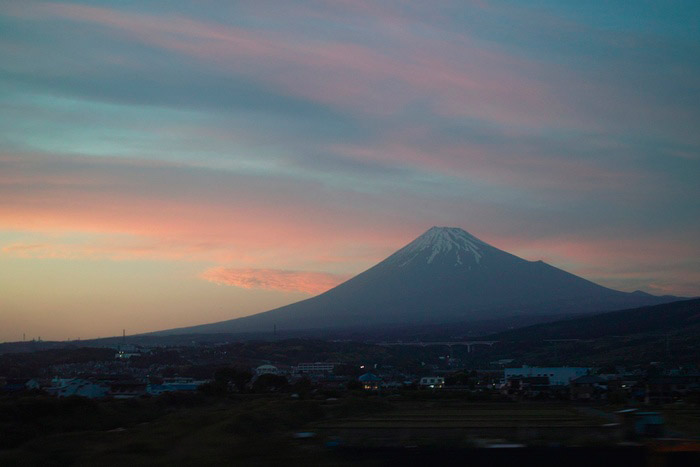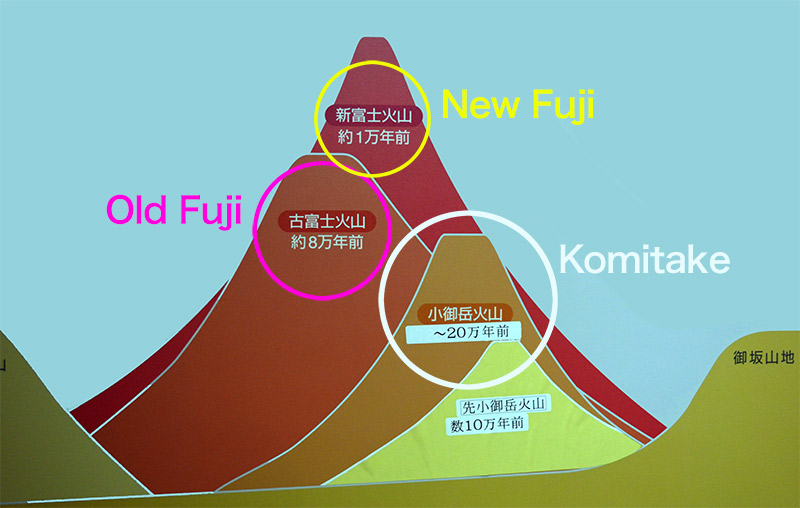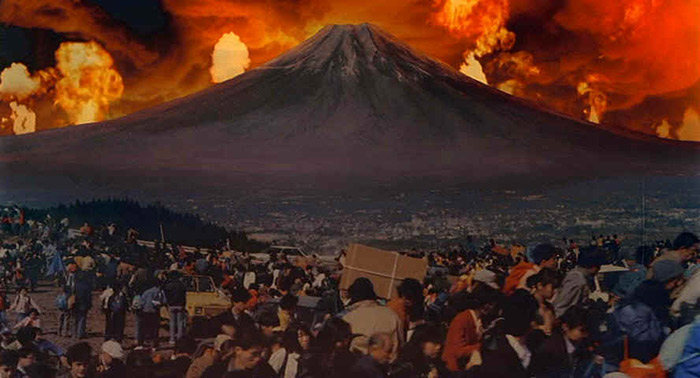That iconic Mt. Fuji shape! Really, when you imagine "Japan" it's difficult for Mt. Fuji not to show up. Up there with samurai, sushi, and Tom Cruise, there isn't much out there that is more "Japanese." I mean look at it. It's one of the few mountains in the world that anyone can look at and recognize based off its shape alone, I think.

For me I think the distinctiveness comes from how the slope of the mountain curves inward. That's what really makes this mountain look so unique. Plus, you can't go 50 shaku in Japan without running into a picture, woodblock print, illustration, or body pillow that doesn't have Fuji on it. Mt. Fuji = Japan.
But, for how long will this Mt. Fuji honeymoon period last? Despite just recently receiving the honor of becoming a World Heritage Site, possibly as positive reinforcement for the 300+ years without a temper tantrum, Mt. Fuji may soon look quite different if its upcoming eruption has anything to say about it. Just like most impending disasters though, the eruption of Mt. Fuji is supposedly "long overdue." It could happen at any moment! Maybe it's happening as I write this blog post right now! Or, maybe it will happen in the next 100 years. Nobody knows for sure, but everyone knows that a big one is coming… eventually.
But, in order to understand its future behaviors we have to look at a younger and more rambunctious Mt. Fuji of the past. Let's take a look at the history of the terrifying mountain-shaped pressure cooker of doom known as Fuji.
Before Mt. Fuji…
Through eruptions, plate movements, collapsing, and earthquakes, the Mt. Fuji you see today was miraculously formed. But, Mt. Fuji didn't always look the way that it looks right now. In fact, there were several other volcanoes in Mt. Fuji's place before it, so let's take a look at some of those.
Komitake Volcano

The Komitake Volcano currently makes up the northern part of Mt. Fuji, and became an active volcano 700,000 years ago. You can visit the Komitake Volcano peak even today if you climb the north face of Mt. Fuji and visit the fifth station. It is 7,500 feet and 2,300 meters above sea level, a little more than half the height of today's Mt. Fuji. It's also almost entirely covered by current-day Mt. Fuji. Think of it like a nice big hug.
Old Fuji
Before there was "Fuji" there was "Old Fuji." Around 100,000 years ago, on the South side of Komitake Old Fuji erupted, sending out brass-colored volcanic mud flows in all directions. It's generally believed that due to all the scoria, volcanic ash, and lava that it spewed it was able to form quite a large mountain reaching up to 10,200 feet (3,100 meters). That's approximately 1/3 the height of Mt. Everest but actually very close to the current height of Mt. Fuji (which is 12,389 ft / 3776.24 m). Old Fuji didn't completely envelope Komitake, though I do think it's fair to say there's a new sheriff in town at this point.
New Fuji
Following the Old Fuji period there was around 4,000 years of inactivity. Then, between 5-10,000 years ago New Mt. Fuji became active, spewing out a bunch of lava, magma, scoria, ash, and certainly much more. This all covered Old Fuji as well as Komitake, combining into a sort of mega volcano. Yes, the three volcanoes Voltron'd together to create a formidable volcano power.
Mt. Fuji was just getting started at this point in history, though. It exploded and exploded staying extremely active, so much so that some geologist called it "the department store of eruptions" (What does that even mean? Geologists think they're soooo funny.).
The Eruptions Of New Fuji

New Mt. Fuji's reign of terror really began in the Jomon period of Japan (around 3000 years ago). Four big eruptions really rounded out this era. They were known as the Sengoku Scoria, the Osawa Scoria, the Omuro Scoria, and the Sunazawa Scoria. Here's a little tidbit of knowledge: The Osawa Scoria wast the only one to spew ash to the West. Most Mt. Fuji eruptions get carried East into Edo/Tokyo, but I guess the East Winds were feeling especially gusty that day.
2,300 years ago marked one of the largest Mt. Fuji related disasters in my mind, though. The eastern face of Mt. Fuji collapsed and liquid mud flowed down to the Gotenba area reaching as far as the Ashigara Plains in the east and the Suruga Bay to the south. That's a lot of covered area. It'd be terrifying to see something similar happen in this day an age (and according to some new research, it seems like it's totally possible… more on that later).
From the 8th century onwards, records get a lot better and information on Mt. Fuji eruptions becomes more accurate. It's also when we start to get a better feel for how often Mt. Fuji erupts and what the warning signs are. In 864 AD, Mt. Fuji's northeast side erupted for 10 days shooting cinders and ash as far away as Edo Bay. It also filled up a large lake with lava, which ended up dividing the lake into two smaller lakes. The lava that did this also became the base for the infamous Aokigahara forest, which is also known as "suicide forest" for the many people who go there to commit suicide. So in a way the lava continues to take lives, even to this day.
After the 864 eruption there were around ten more eruptions until 1083, when Japan made a collective sigh of relief at 400 years of inactivity. Then, Mt. Fuji became active again between 1511 and 1707, the last eruption happening a week after the Great Hoei Earthquake.

A lot of people looked to this earthquake as a warning after the 2011 Tohoku Earthquake. Big earthquakes trigger volcanic eruptions, which is exactly what happened in the case of the Great Hoei Quake. A particularly large eruption occurred spewing tons of ash and scoria as far as Edo (Tokyo). After this big one, though, things got quiet. Too quiet. Since 1707 there haven't been any eruptions to speak of. What is Mt. Fuji doing? What is it waiting for? WHO is it waiting for? I suppose we'll just have to wait to find out.
An Increase In Pressure
Nowadays "New" Mt. Fuji isn't all that new anymore, so I guess that's why people just call it plain old "Mt. Fuji" now. Perhaps if there's another Mt. Fuji in the future they can call it "Neo Mt. Fuji" along with Neo Tokyo. It would have a nice ring to it, I think. Anyways, let's see what current-day Mt. Fuji has been up to…
After the 2011 Tohoku Earthquake, many people started to worry about Mt. Fuji as well. it's not uncommon for a big earthquake to trigger volcanic activity, and the Tohoku Earthquake was certainly a big one. After the quake, Fuji lava chamber pressure increased to 1.6 megapascals. Considering volcanic activity can be triggered by as little as 0.1 megapascals, this led many to believe that something big was about to happen.
Then nothing happened. To be fair, there's plenty of room for waiting, though. Volcanoes are slow, patient beasts.
Although researcher professor Masaki Kimura of Ryukyu University claimed that the eruption should have happened in 2011, he also placed a 4-year margin of error onto his prediction. So if he's right, Fuji should erupt sometime between right now this very moment and sometime in 2015. We'll all hold our breaths until then.
But there is a lot of evidence backing up the thought that Mt. Fuji will erupt in the near future. More than just magma chamber pressure, seismic activity around Mt. Fuji has been gradually increasing as well. Cracks in the crust have been growing. Tunnels have collapsed not due to earthquakes but due to "deformation," which means the mountain itself is bending and shifting. Water levels in lakes have been rising, possibly because magma levels are rising as well, melting off more permafrost and creating more liquid water. Just like Mt. Saint Helens before it erupted, Mt. Fuji has been experiencing increased "phreatic eruptions" (eruptions of steam and water). Things do not bode well for the Fuji.
On top of all this, a recent discovery of a fault-line underneath Mt. Fuji has been made, with a theoretical output of up to a magnitude seven earthquake. This isn't the worst part, though. It could also be the same fault-line that was responsible for the giant Gotenba mud slide and there's no reason for that not to happen again if all the stars align just right. In fact, Mt. Fuji has "collapsed" like this five times in the last 100,000 years, so chances are better than the lottery, at least.
So, it's not really a matter of "if" Mt. Fuji erupts anymore. It's more a matter of "when." When it does happen, it's thought that the eruption will occur on the Northeast corner (though the main crater could erupt at the same time as well). That being said, nobody really knows what a volcano is thinking, so we'll just have to wait and see. My guess is that it will line up with the big upcoming Tokyo-area quake that everyone's waiting for, also poised to happen at any moment now.
Then again, you could just listen to this guy's prophecy instead.

So, be sure to ride a couple of the greatest roller coasters in the world before it blows its top. If I had to make an estimate as to when I think Mt. Fuji will explode… well… just be sure to read this article after it already happens, because then I can edit this post and write in the exact date, pretending like I knew all along.
KOICHIDAMUS OUT.
*Drops mic on ground*
